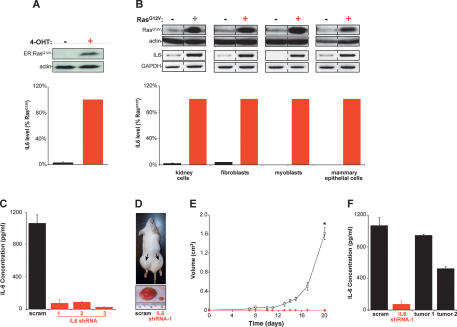Figure 1.
Oncogenic Ras-induced secretion of IL6 is required for Ras-mediated tumorigenesis. (A) IL6-secreted protein levels increase upon activation of Ras. Human kidney cells expressing T/t-Ag, hTERT, and ER:RasG12V (and p110-CAAX) were confirmed by immunoblot to up-regulate ER:RasG12V in the presence of 4-OHT (top), which led to elevated levels of IL6 (percent relative to RasG12V-expressing cells) present in cell medium as detected by ELISA (bottom). (Actin) Loading control. (B) Oncogenic Ras increases secreted IL6 independent of cell type. The indicated four primary human cell types expressing T/t-Ag and hTERT and, where indicated, also RasG12V, as assessed by immunoblot (top), were shown to increase the levels of IL6 mRNA, as assessed by RT–PCR (middle), and secreted IL6 protein (percent relative to RasG12V-expressing cells), as assessed by ELISA (bottom) upon expression of RasG12V. (Actin) Loading control; (GAPDH) RT–PCR control. (C) Primary human kidney cells expressing T/t-Ags, hTERT, RasG12V, and shRNA-1, shRNA-2, and shRNA-3, but not a scramble (scram) control sequence, exhibited a decrease in secreted IL6 as assessed by ELISA. (D) Knockdown of IL6 (IL6 shRNA-1) in the aforementioned human kidney cells induced decreased tumor growth, as visualized in a representative mouse (arrow, tumor) or ressected tumors, when compared with scramble control-treated cells (scram). (E) IL6 is required for Ras-driven tumor growth. A plot of tumor volume (cubic centimeters) ± standard error versus time in days for the aforementioned human kidney cells expressing the scramble control sequence (open box) or the three different IL6 shRNAs (as growth kinetics were identical, tumor growth in mice injected with cells expressing any of the three IL6 shRNAs is shown with one symbol [red diamond]) when injected in mice. (*) P < 0.001 (F) Two tumors (tumor 1, tumor 2), eventually arising when the aforementioned human kidney cells expressing IL6 shRNA-1 were isolated, were cultured briefly in hygromycin to enrich for tumor cells and assayed for secreted IL6 by ELISA, with the finding that these tumors exhibited increased IL6 compared with the original IL6 shRNA-1 donor cells, almost to the level of scramble (scram) control cells.

